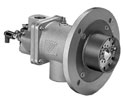Not all combustion equipment is suitable for pulse-firing. Some of the key equipment requirements for a successful pulse-fire installation include: operating cycles in excess of one million, capability of three cycles per minute, and repeatability.
Solenoid Valve Operating Cycles
 In traditional, modulating systems, gas solenoids open during start-up and remain open during furnace operation. Unless there is a problem, the valves don’t need to close until the shut-down procedure is initiated. In a pulse-fire system, gas and air solenoid valves are actuated open and allowed to close repeatedly. Achieving on/off or high-fire/low-fire pulsing patterns require these valves to perform several hundred-thousand cycles. If valves that cannot handle these requirements are installed, they quickly fail, and the cost of constantly replacing spent solenoid valves outweighs the savings typically seen with pulse-fire.
In traditional, modulating systems, gas solenoids open during start-up and remain open during furnace operation. Unless there is a problem, the valves don’t need to close until the shut-down procedure is initiated. In a pulse-fire system, gas and air solenoid valves are actuated open and allowed to close repeatedly. Achieving on/off or high-fire/low-fire pulsing patterns require these valves to perform several hundred-thousand cycles. If valves that cannot handle these requirements are installed, they quickly fail, and the cost of constantly replacing spent solenoid valves outweighs the savings typically seen with pulse-fire.
Reliable Burners
 When talking about pulse-fire, it is often said that any burner that can handle it can be pulse-fired, but what exactly does this mean? In the case of on/off operation, it seems obvious; the burner must light reliably. Many people hear about the pulse-firing method, and they want to upgrade their existing system, but don’t want to get into the cost of new burners. However, if there are any burner-reliability concerns, it may be best to plan on replacing them.
When talking about pulse-fire, it is often said that any burner that can handle it can be pulse-fired, but what exactly does this mean? In the case of on/off operation, it seems obvious; the burner must light reliably. Many people hear about the pulse-firing method, and they want to upgrade their existing system, but don’t want to get into the cost of new burners. However, if there are any burner-reliability concerns, it may be best to plan on replacing them.
The piping to your burners may change when implementing pulse-fire as well. To achieve the correct ratio control, a ratio regulator must be installed on each burner train, along with a valve for air modulation – either an air solenoid, or a solenoid-actuated butterfly, rated for high operating cycles.
Pulse Controller
 In addition to high operating cycle gas and air solenoids, additional ratio regulators and reliable burners, a pulse controller is also needed. This is the component that signals the valves to open and close according to a programmable time-proportion algorithm, cycling burners on/off or high/low.
In addition to high operating cycle gas and air solenoids, additional ratio regulators and reliable burners, a pulse controller is also needed. This is the component that signals the valves to open and close according to a programmable time-proportion algorithm, cycling burners on/off or high/low.
Pulse control can be achieved through a PLC, or by using a dedicated pulse control module, which typically mounts in a PF-19 rack or on the door or din rail of a control panel.
Burners are fired in relation to a control output, such as the CV of a PID loop controller. Since the high-turbulence furnace atmosphere which results from pulse-firing greatly reduces hot spots, temperatures reported by thermocouples are more likely to describe a uniform condition.
NEXT: Pulse-fire Implementation
Now that you’re familiar with the history, ideas, and benefits of pulse-fire, it’s time to look at implementation. Knowing what you do about the demands that pulse-firing exacts upon components, you want to make sure to get the most for your money, so you don’t wind-up spending your fuel savings on replacements.
Watch for our next blog, with an in-depth look at Kromschröder equipment.











